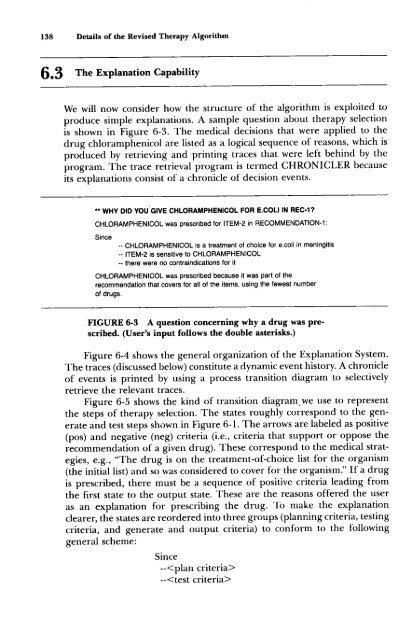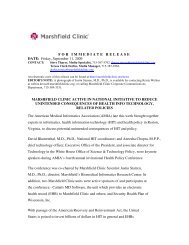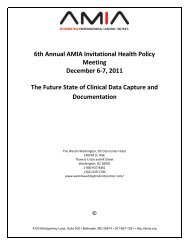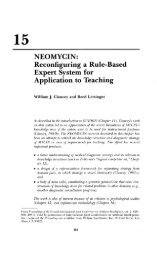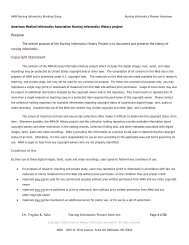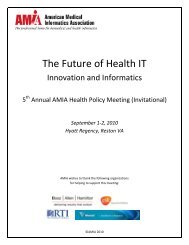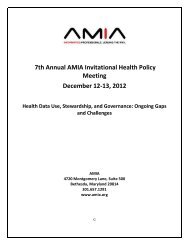Rule-Based Expert Systems: The MYCIN Experiments of ... - AITopics
Rule-Based Expert Systems: The MYCIN Experiments of ... - AITopics
Rule-Based Expert Systems: The MYCIN Experiments of ... - AITopics
You also want an ePaper? Increase the reach of your titles
YUMPU automatically turns print PDFs into web optimized ePapers that Google loves.
138 Details <strong>of</strong> the Revised <strong>The</strong>rapy Algorithm6.3<strong>The</strong> Explanation CapabilityWe will now consider how the structure <strong>of</strong> the algorithm is exploited toproduce simple explanations. A sample question about therapy selectionis shown in Figure 6-3. <strong>The</strong> medical decisions that were applied to thedrug chloramphenicol are listed as a logical sequence <strong>of</strong> reasons, which isproduced by retrieving and printing traces that were left behind by theprogram. <strong>The</strong> trace retrieval program is termed CHRONICLER becauseits explanations consist <strong>of</strong> a chronicle <strong>of</strong> decision events.** WHY DID YOU’GIVE CHLORAMPHENICOL FOR E.COLI IN REC-I?CHLORAMPHENICOL was proscribed for ITEM-2 in RECOMMENDATION-1 :Since -- CHLORAMPHENICOL is a treatment <strong>of</strong> choice for e.coli in meningitis-- ITEM-2 is sensitive to CHLORAMPHENICOL-- there were no contraindications for itCHLORAMPHENICOL was prescribed because it was part <strong>of</strong> therecommendation that covers for all <strong>of</strong> the items, using the fewest number<strong>of</strong> drugs.FIGURE 6-3 A question concerning why a drug was prescribed.(User’s input follows the double asterisks.)Figure 6-4 shows the general organization <strong>of</strong> the Explanation System.<strong>The</strong> traces (discussed below) constitute a dynamic event history. A chronicle<strong>of</strong> events is printed by using a process transition diagram to selectivelyretrieve the relevant traces.Figure 6-5 shows the kind <strong>of</strong> transition diagramwe use to representthe steps <strong>of</strong> therapy selection. <strong>The</strong> states roughly correspond to the generateand test steps shown in Figure 6-1. <strong>The</strong> arrows are labeled as positive(pos) and negative (neg) criteria (i.e., criteria that support or opposerecommendation <strong>of</strong> a given drug). <strong>The</strong>se correspond to the medical strategies,e.g., "<strong>The</strong> drug is on the treatment-<strong>of</strong>-choice list for the organism(the initial list) and so was considered to cover for the organism." If a drugis prescribed, there must be a sequence <strong>of</strong> positive criteria leading fromthe first state to the output state. <strong>The</strong>se are the reasons <strong>of</strong>fered the useras an explanation for prescribing the drug. To make the explanationclearer, the states are reordered into three groups (planning criteria, testingcriteria, and generate and output criteria) to conform to the followinggeneral scheme:Since----


